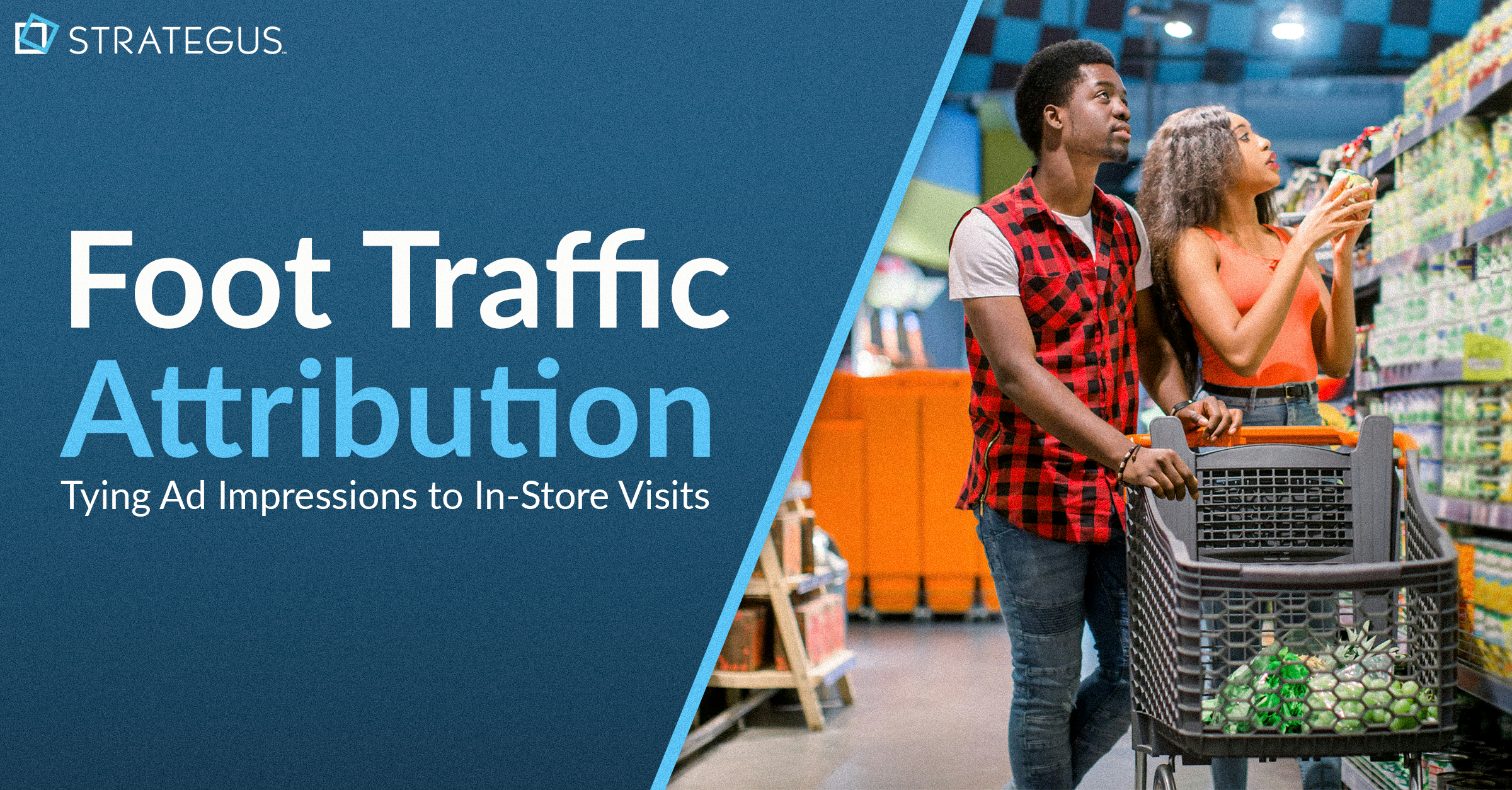- Home
- Strategus Blog
- Foot-Traffic Attribution: Tying Ad Impressions to In-Store Visits
Foot-Traffic Attribution: Tying Ad Impressions to In-Store Visits
 Traci Ruether
Traci Ruether
8 minutes read

The marketing funnel has changed. Today’s shoppers often begin researching products from the comfort of their homes and don’t set foot into a store until they’re ready to make a purchase. Marketers must engage these buyers on their own terms, which is why digital advertising has become an essential part of every brand’s media mix.
Thanks to programmatic advertising channels like connected TV (CTV), display, social media, and streaming audio, advertisers can target users who are most likely to buy with performance-driven campaigns. These digital channels also make it easy to measure the return on ad spend (ROAS) when buyers convert online.
But what about the people who see an ad for a local furniture retailer and then choose to check the store out in person rather than heading to the website? Is it possible to tie ad exposure to a purchase when the customer journey spans online and offline channels?
As a matter of fact, it is — all thanks to foot-traffic attribution. Keep reading to find out how foot-traffic attribution works and the critical role it plays in multi-channel CTV campaigns.
What Is Foot-Traffic Attribution?

Foot-traffic attribution gives businesses the ability to attribute physical store visits to ad campaigns using GPS data from mobile devices. This connects real-world business outcomes with digital media spend, which is crucial for both measuring performance and optimizing marketing efforts.
What Role Does It Play in CTV Advertising?
Any brand with brick-and-mortar locations should be using foot-traffic as a campaign KPI. And because CTV is a proven channel for local ad campaigns, combining the two is a no-brainer. Besides, CTV offers a unique advantage when it comes to driving foot traffic.
Unlike other digital channels that often target users who are multitasking on their phones or laptops, CTV reaches audiences in their living rooms, capturing their attention on the biggest screen in the house. This creates a powerful opportunity to influence their behavior and drive them to visit your store.
Why Does this Matter For Brands and Agencies
Imagine seeing an ad for a local health food store while watching the nightly news, and then checking it out a few weeks later while running errands in the area. With foot-traffic attribution, the media buyers or in-house marketers responsible for running that ad would be able to tie your visit to their efforts, and thereby gain valuable insight into the impact that they had.

Moreover, CTV allows for precise audience targeting, ensuring that these ads are only seen by people most likely to be interested in a given product or service. This targeted approach creates a potent combination for driving foot traffic, making it possible to personalize the messaging based on promotional events or local deals.
Benefits of Foot-Traffic Attribution
For traditional street-side businesses, tying advertising effort to in-store visits is what it’s all about. Foot-traffic attribution does just this, laying the foundations for a more data-driven approach. Measuring in-store visits is critical for performance TV campaigns, but even for general awareness campaigns, it can help give a directional read on brand lift.
With foot-traffic attribution, advertisers can:
 Measure Campaign Impact: If physical traffic is part of the customer journey and you’re only tracking click and impressions, you’re likely doing a lot of guesswork and falsely correlating data points. Foot-traffic attribution solves this, providing holistic insight into how your campaigns are contributing to business results.
Measure Campaign Impact: If physical traffic is part of the customer journey and you’re only tracking click and impressions, you’re likely doing a lot of guesswork and falsely correlating data points. Foot-traffic attribution solves this, providing holistic insight into how your campaigns are contributing to business results. Optimize Their Media Mix: Multi-touch attribution allows you to identify which ads and channels are most effective and reallocate budget accordingly. This proactive approach is key to minimizing ad waste — especially when delivering omnichannel campaigns that retarget viewers across other digital channels.
Optimize Their Media Mix: Multi-touch attribution allows you to identify which ads and channels are most effective and reallocate budget accordingly. This proactive approach is key to minimizing ad waste — especially when delivering omnichannel campaigns that retarget viewers across other digital channels. Improve the Customer Experience: By understanding which ads and creative elements are driving in-store visits, you can tailor the entire customer journey for a more seamless and engaging experience. This might involve aligning in-store displays with your most effective ad creatives or offering promotions that complement your messaging.
Improve the Customer Experience: By understanding which ads and creative elements are driving in-store visits, you can tailor the entire customer journey for a more seamless and engaging experience. This might involve aligning in-store displays with your most effective ad creatives or offering promotions that complement your messaging.
How Does Foot Traffic Attribution Work?
Foot-traffic attribution uses smartphone GPS data to connect the dots between ad views and in-store visits. At Strategus, we work with brands and agencies to implement a simple four-step process for capturing this insight.

At Strategus, we offer the largest suite of customizable attribution solutions in the industry. Here’s a look at the myriad tools that we offer all of which can be mixed and matched to create a tailored framework.
Step 1: Define Target Locations
The first step is identifying which locations you want to track in relation to a campaign. This might be a single flagship store or a handful of locations across a specific region. The more precise that we can get at this step, the more accurate the attribution data will be.
Step 2: Measure Validated Foot Traffic
Once we know where to look, we’ll start measuring store visits that can be tied to ad campaigns using anonymized location data from mobile devices. We use sophisticated algorithms to filter out irrelevant data and maintain privacy compliance.
Step 3: Connect In-Store Visits With Ad Exposure
The next step is tying ad exposures to store visits. We do this by cross-referencing the device IDs of visitors with our database of viewers who were served your CTV ads.
Step 4: Report on Results
Last but not least, we make this insight actionable by providing a detailed report about the number of store visits driven by your CTV campaigns. Our hands-on experts will also provide analysis about which ads, channels, and creative elements are most effective in driving foot traffic — and make suggestions for optimizing your strategy. For instance, we may discover that ads featuring a particular product were more likely to drive in-store visits, in which case we’d recommend showcasing that product more prominently across the entire campaign.
Brands Driving Tangible Results Using Foot-Traffic Attribution From Strategus
Every business is different. So at Strategus, we create a custom media mix and attribution model for every brand we work with. Here’s a look at the impact this approach has had across industries that rely most on in-store purchases.
Furniture Retailer Drives 9,000+ In-Store Visits
Arwoods Furniture, a Kansas City-based retailer, partnered with us to drive measurable foot traffic using CTV ads. With a strategy that combined precise audience targeting, compelling creative, and cross-device retargeting, our campaign drove over 9,000 in-store visits within a six-week period.
Pizza Franchise Increases Foot Traffic by 31%
A regional pizza franchise teamed up with us to implement CTV for the first time — with a goal of boosting in-store visits and sales across its 110 store locations. Within 12 weeks, the franchise achieved a remarkable 31% increase in store visits that could be directly attributed to CTV exposures.
Casino Attracts 52,862 New Visitors
A prominent West Coast casino wanted to increase awareness of their property and attract new visitors. We worked with them to launch a comprehensive CTV advertising campaign that incorporated full-funnel targeting and retargeting strategies. The campaign significantly increased foot traffic to the casino, causing the casino to shift a sizable portion of their linear TV ad budgets over to CTV.
Get Started With Strategus
Correlating online and offline touchpoints isn’t easy, but we’ve baked it into our CTV offering at Strategus to better serve local businesses that depend on in-store traffic. And that’s not all. We offer an ever-evolving roster of attribution solutions that can be customized to any business's goals.
Gain better insight into how your buyer progresses through the funnel. Contact us today.

Traci Ruether is a content marketing consultant specializing in video tech. With over a decade of experience leading content strategy, she takes a metrics-driven approach to storytelling that drives traffic to her clients' websites. Follow her on LinkedIn at linkedin.com/in/traci-ruether or learn more at traciruether.com.
Strategus is a managed services connected TV(CTV) advertising agency with over 60,000+ campaigns delivered. Find out how our experts can extend your team and drive the result that matter most.
Talk to an Expert
Table of Contents
Seeking a Custom CTV Strategy That Delivers?
What to read next

Third-Party Data Targeting for CTV: Benefits & Tactics
Third-party data. It’s a term that’s thrown around, and yet few take the time to detail its pros and cons — much less strategies for using...
7 minutes read

First-Party Data Targeting: Benefits and Tactics for CTV Advertising
First-party data is the information that companies collect directly from their customers rather than through intermediaries. Advertisers use this...
10 minutes read

Foot-Traffic Attribution: Tying Ad Impressions to In-Store Visits
The marketing funnel has changed. Today’s shoppers often begin researching products from the comfort of their homes and don’t set foot into a store...
8 minutes read

CTV Attribution: What It Is and How It Works
Connected TV (CTV) viewing is on the rise — and that’s good news for marketers. Not only can CTV ads be precisely targeted to individual households,...
9 minutes read


















